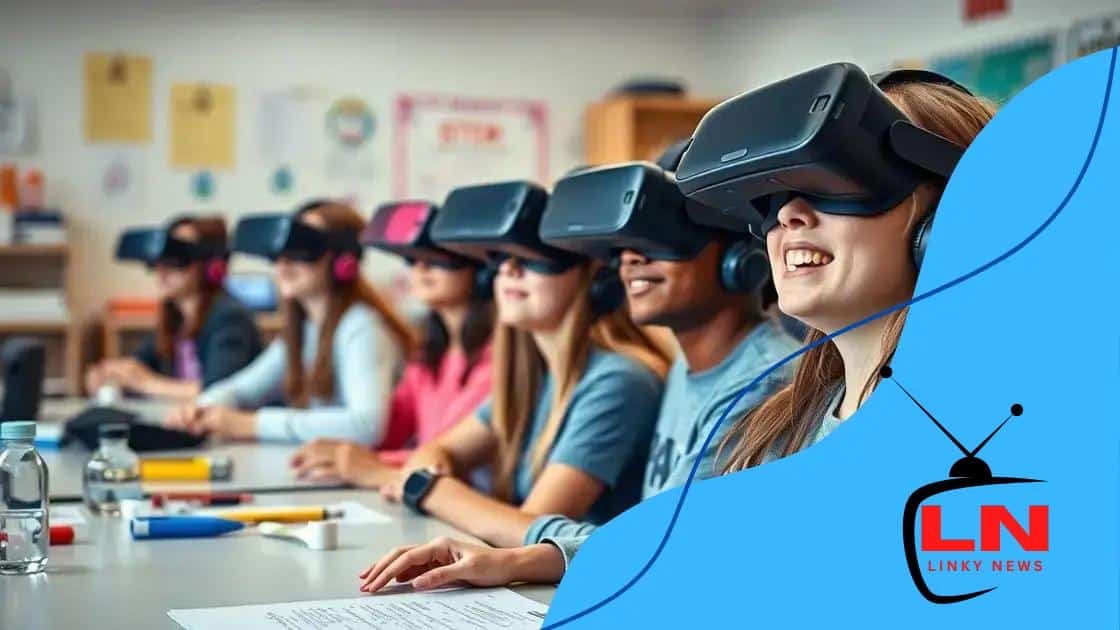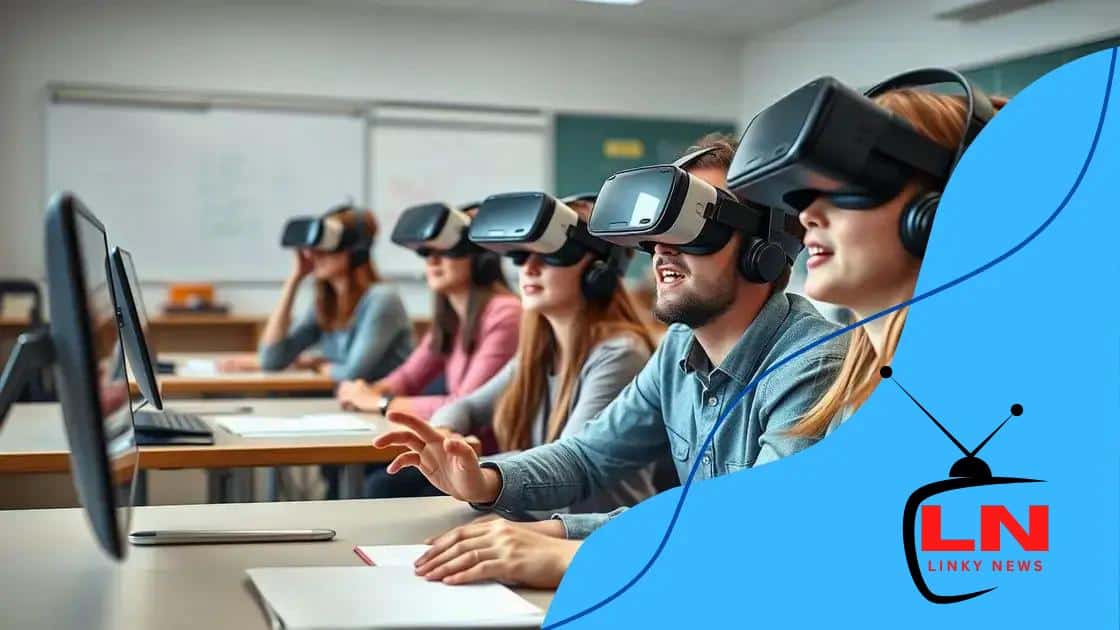Virtual reality STEM education: a game changer for learning

Virtual reality STEM education enhances learning by providing immersive experiences that engage students, improve understanding of complex concepts, and develop critical skills through interactive simulations and collaborative projects.
Virtual reality STEM education is reshaping how we approach learning, providing immersive experiences that captivate students. Have you ever imagined exploring the human body in 3D? That’s just one benefit of integrating virtual reality into STEM subjects.
Understanding virtual reality in education
Understanding how virtual reality works in education is essential for making the most of this innovative technology. It allows students to step into immersive worlds where they can see complex concepts unfold before their eyes. Imagine exploring distant planets in a science class or walking through ancient civilizations in history.
What is Virtual Reality?
Virtual reality is a computer-generated simulation of a three-dimensional environment that can be interacted with using special equipment, such as headsets. This technology creates a sense of presence, where users feel as if they are truly part of the experience.
Benefits of Virtual Reality in Education
Using virtual reality in education brings numerous benefits, enhancing the learning process:
- Improved engagement: Students are more likely to participate in lessons.
- Increased retention: Subjects become memorable through immersive experiences.
- Accessibility: Complex ideas can be visualized clearly, making them easier to understand.
It also fosters collaboration among students, encouraging them to work together in virtual spaces. In a standard classroom, it can be challenging for students to connect social skills. However, with virtual reality, they can communicate and solve problems as a team in a fun, interactive setting.
As schools look to adopt this technology, they must also consider the infrastructure necessary for virtual reality learning. Proper devices, software, and even teacher training are essential for integrating VR effectively into the curriculum. Schools that prioritize these elements can unlock a new world of possibilities for their students.
The impact of virtual reality on STEM learning
The impact of virtual reality on STEM learning is profound and transformative. By immersing students in interactive environments, they can better grasp challenging concepts. Imagine learning physics by experiencing forces in a virtual lab or understanding biology by exploring the human anatomy from the inside. These experiences turn abstract ideas into tangible realities.
Enhancing Understanding Through Experience
One significant advantage of virtual reality is its ability to enhance understanding by providing experiential learning opportunities. Unlike traditional methods, students can visualize complex theories in a realistic context. When they interact with 3D models, it becomes easier to comprehend intricate details that are hard to visualize in a textbook.
Encouraging Problem Solving
Furthermore, virtual reality encourages critical thinking and problem-solving skills. In a VR setting, students can tackle real-world challenges, working together to devise solutions. This simulates real-life applications of their knowledge, making learning more applicable and engaging.
- Immersive environments boost engagement.
- Real-life problem-solving enhances retention.
- Collaboration in virtual spaces fosters teamwork.
This teaching method is becoming a valuable tool for educators. As technology evolves, the scope of virtual reality in STEM education continues to expand. Schools that adopt it can provide more interactive and dynamic learning experiences. Ultimately, this leads to higher student interest and better educational outcomes.
How to implement virtual reality in the classroom

Implementing virtual reality in the classroom can revolutionize teaching methods and enhance student engagement. Teachers can create an environment where learning becomes dynamic and interactive. By incorporating VR technology, lessons transform into captivating experiences, which help students fully grasp the subject matter.
Steps to Implement Virtual Reality
There are several important steps for educators to consider when integrating virtual reality into their classrooms.
- Choose the right VR tools: Select devices that are user-friendly and appropriate for the age of your students.
- Plan your lessons: Design lessons that include virtual reality experiences, aligning them with curriculum goals.
- Train the staff: Provide adequate training for teachers to feel comfortable using VR technology.
Engaging students is crucial, and virtual reality offers unique opportunities to do so. For example, students can explore the solar system, travel through time, or dive into the ocean without leaving the classroom. This immersive learning experience encourages curiosity and motivates students to learn more.
Overcoming Challenges
While the benefits are clear, implementing virtual reality may come with challenges. Some educators may worry about costs or the time needed to prepare lessons. However, these hurdles can be overcome with careful planning and collaboration among staff.
Schools can look for grants or partnerships with technology providers to acquire necessary resources. Additionally, many free or low-cost VR platforms exist, allowing schools to experiment without significant financial commitment.
Ultimately, the goal of integrating virtual reality is to create engaging and inspiring learning environments. With proper implementation, this technology can lead to remarkable educational experiences for students.
Real-world examples of virtual reality in STEM
Real-world examples of virtual reality in STEM education demonstrate the technology’s practical applications and effectiveness. Schools and organizations around the globe have embraced VR to enhance learning experiences. These applications show how engaging and impactful immersive education can be.
Virtual Reality in Science Classes
In science classes, students can explore intricate processes that are difficult to replicate in a traditional classroom. For example, programs like Labster allow students to conduct virtual experiments in a simulated lab environment. This enables them to learn in-depth about topics such as chemistry and biology without the usual constraints of physical resources.
Exploring Historical Events Through VR
Another fascinating use of virtual reality is in history lessons. Schools can take students back in time to experience significant historical events firsthand. With VR, students can walk through ancient cities or witness key moments in history. This offers a profound understanding that textbooks alone cannot provide.
- The British Museum offers virtual tours, allowing students to explore ancient artifacts from anywhere.
- VR experiences can simulate life in different historical eras, enhancing student engagement.
In mathematics, VR programs help students visualize complex structures and geometric shapes. They can manipulate these shapes in a three-dimensional space, improving their spatial awareness and problem-solving skills. Programs like Geometry Dash VR make learning math fun and interactive.
Engineering and Design Applications
Engineering students benefit greatly from virtual reality as well. They can design and test their projects in a virtual environment. This not only saves resources but also speeds up the design process. Using tools like Unity for VR development, students can create their projects and visualize their ideas.
These real-world examples showcase how virtual reality in STEM education enriches learning, making it more compelling and effective. As technology advances, the possibilities for integrating VR into educational settings are limitless, paving the way for future innovations.
Future trends in virtual reality and education
Future trends in virtual reality and education promise to shape the learning landscape in unprecedented ways. As technology continues to evolve, the potential applications of VR in educational settings are expanding, making learning even more engaging and effective.
Increased Accessibility
One trend is the increased accessibility of virtual reality tools. As costs decrease and technology improves, more schools can implement VR in their classrooms. This will create a more level playing field, allowing students from diverse backgrounds to experience immersive learning.
Personalized Learning Experiences
Another trend is the move towards personalized learning. Virtual reality can adapt to individual student needs, allowing them to progress at their own pace. With tailored experiences, students can explore subjects in a way that resonates with their unique learning styles. This approach can significantly enhance comprehension and retention of information.
- Adaptive learning environments using AI in VR.
- Customization of content based on student preferences.
- Real-time feedback to track progress and understanding.
Integrating VR with artificial intelligence opens new possibilities in education. AI can analyze student interactions within VR environments and provide insights on how to improve their learning experience. This combination can enhance engagement and make lessons more effective than traditional methods.
Collaborative Learning Opportunities
Additionally, the future of virtual reality in education includes collaborative learning experiences. Students from different locations can join the same virtual classroom, fostering teamwork and communication skills. These experiences not only broaden their horizons but also prepare them for the global workforce.
As we look ahead, the possibilities for integrating virtual reality in education are vast. From gamified learning experiences to enhanced engagements through social VR, the future holds great promise for students and educators alike. Adopting these innovations will revolutionize how we think about teaching and learning.
FAQ – Frequently Asked Questions about Virtual Reality in Education
How can virtual reality enhance student learning?
Virtual reality makes learning engaging by immersing students in interactive experiences that help them understand complex concepts.
What are some real-world examples of virtual reality in STEM education?
Examples include virtual lab experiments, historical simulations, and collaborative engineering projects.
How accessible is virtual reality technology for schools?
As costs decrease and more resources become available, many schools can now integrate virtual reality into their classrooms.
What skills can students develop through virtual reality experiences?
Students can develop critical thinking, problem-solving, collaboration, and adaptability skills through immersive VR learning environments.





